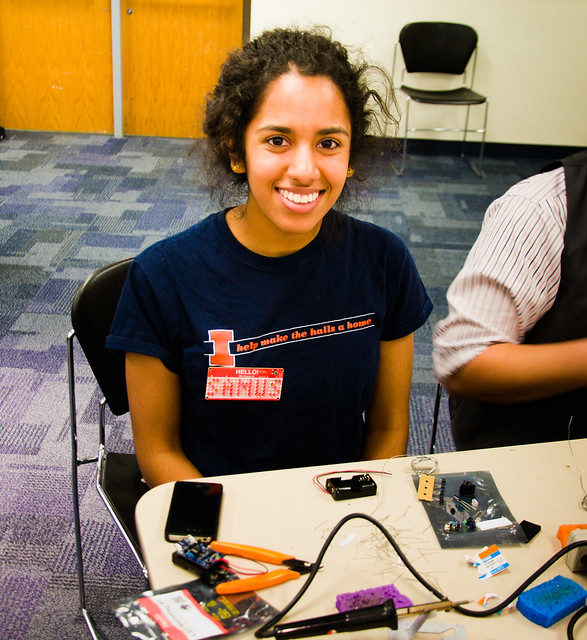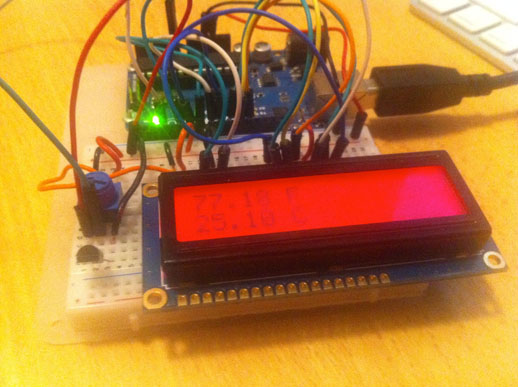LED nametags at University of Illinois
Mitch Altman has been spending the last couple weeks as an artist in residence at the University of Illinois. One of his workshops featured our LED nametags. He took some great photos, and I wanted to share a few here (all photos by Mitch Altman).
Check out some more fantastic photos from the rest of Mitch’s residency in his Urbana, IL Feb 2014 photoset.
This entry was written by , posted on February 15, 2014 at 4:56 am, filed under Uncategorized and tagged nametag. Leave a comment or view the discussion at the permalink.
Bay Area Maker Faire 2012
I’m super excited to be exhibiting at the Bay Area Maker Faire this year!
Maker Faire first convinced me that hardware hacking could be approachable. From my about page:
After stopping by a ‘learn to solder’ station at MakerFaire in 2010, (Larry) was hooked, and left San Mateo with an Arduino. Later that night he successfully got some LEDs to blink on demand!
It’s really amazing to be a small part of it this year.
I’m going to be demoing a computer controlled toy xylophone. I’m calling it the Lullaby Machine.
This has been a really fun project to work on. I’ll be writing more about it in some future blog posts.
Anyway, if you’re coming to Maker Faire this weekend (and you should!) please stop by and say hello!
(oh, p.s., our led nametag kits will be available in the Maker Shed store!)
This entry was written by , posted on May 16, 2012 at 5:20 am, filed under Uncategorized. Leave a comment or view the discussion at the permalink.
Ambient temperature display
This is a really simple ambient display for temperature using an arduino, an adafruit RGB backlight LCD, and a temperature sensor.
The LCD displays the temperature in Fahrenheit and Celsius and adjusts the color of the backlight depending on the reading. An ideal range is set at 61F to 67F. If the temperature is in this range the backlight will change green. Above this range and the color will change red, below the range it will change blue.
The great thing about these kinds of displays is that you can immediately get some rough information from across the room.
This is just a quick project. An obvious improvement is to have more variations in color depending on how far you are from your ideal range. I.e. as the temperature increases out of the ideal range, move along the color wheel and use shades of yellow, then orange before hitting red. There’s also a lot of empty room on that LCD. Possibly room for data from other sensors, or maybe just a larger (2-line) font.
Here’s a short video showing it in action (sorry, it’s a little hard to read the display in this video):
This entry was written by , posted on January 30, 2012 at 3:09 am, filed under Uncategorized and tagged arduino. Leave a comment or view the discussion at the permalink.
custom nametag font at noisebridge
Olya built this name tag at Noisebridge last Monday at Circuit Hacking Monday.
I really love the wide-letter font she came up with, especially the exclamation point. I’m planning on swapping out the current one for hers, it’s much nicer.
I’d love to hear about / see and other fonts or font suggestions out there. If you have one, please get in touch.
If you’re interested in building your own LED name tag, stop by Noisebridge on Mondays.
This entry was written by , posted on December 17, 2011 at 6:46 am, filed under Uncategorized and tagged nametag. Leave a comment or view the discussion at the permalink.
Hello My Name is LED
Today we’re releasing our first open source electronics kit – an LED Nametag.
It comes with 4 built-in programs: all letters on, letter chase, fade, and blink. It also includes a power-save mode.
The code is open source and you can reprogram the nametag by adding an ISP header.
The LED layout is pretty simple. It’s 20 columns across and 5 rows down. It’s sub-divided into blocks of 4 columns by 5 rows. This is the most granular control (and used by the letter chase effect).
As part of the project, we’ve developed a simple font and a name layout tool. Check it out and see how your name will look!
I’d love it if people came up with additional fonts, icons, symbols, etc. that could be displayed on the name tags. Please get in touch if you come up with something!
I am really happy with how this kit came out. The PCBs took a few revisions to get ‘just right’, but they do look great.
Check out the kit on the nametag project page.
This entry was written by , posted on October 25, 2011 at 3:39 pm, filed under Uncategorized and tagged kit. Leave a comment or view the discussion at the permalink.














